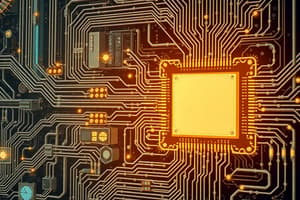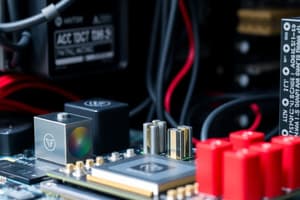Podcast
Questions and Answers
Which electronic device is NOT classified as an input device?
Which electronic device is NOT classified as an input device?
- Printer (correct)
- Keyboard
- Joystick
- Webcam
What is the primary function of the CPU in a computer?
What is the primary function of the CPU in a computer?
- To store information permanently
- To present output on display units
- To execute input operations
- To process and execute instructions (correct)
Which of the following accurately describes auxiliary storage?
Which of the following accurately describes auxiliary storage?
- It provides long-term and permanent data storage. (correct)
- It is faster than the primary memory.
- It is only used for temporary storage.
- It consists primarily of input devices.
According to the definitions provided, which of the following items is NOT part of a computer's structure?
According to the definitions provided, which of the following items is NOT part of a computer's structure?
Who is credited with the conceptual beginnings of the computer?
Who is credited with the conceptual beginnings of the computer?
What was a significant feature of first generation computers?
What was a significant feature of first generation computers?
Which computer was the first for commercial use in the second generation?
Which computer was the first for commercial use in the second generation?
What innovation characterized the third generation of computers?
What innovation characterized the third generation of computers?
What role did programming languages play in the second generation of computers?
What role did programming languages play in the second generation of computers?
Which operating system was introduced in 1980 that influenced the third generation of computers?
Which operating system was introduced in 1980 that influenced the third generation of computers?
Flashcards are hidden until you start studying
Study Notes
What is a Computer?
- A computer is an electronic machine that processes and stores information
- Computers are comprised of wires, transistors, circuits, instructions, and data that can transmit, store, and manipulate information
- Computers accept data as input, process it, then provide the information as an output
- Computer components include an input device (e.g., keyboard, mouse), Central Processing Unit (CPU), storage unit (e.g., Hard Disk), and output device (e.g., monitor, printer)
Basic Computer Operations
- Input: Receiving information from users through input devices
- Storage: Storing information using storage devices, such as the CPU and auxiliary memory
- Processing: Executing instructions and manipulating data controlled by the CPU
- Output: Presenting processed results from the CPU to the user
History of the Computer
-
First Generation (1937-1946):
- The Atanasoff-Berry Computer (ABC) was built in 1937 as the first electronic digital computer
- The Colossus was built in 1943 for military purposes
- ENIAC (Electronic Numerical Integrator and Computer) was developed in 1946 as the first general-purpose digital computer
- Early computers relied on vacuum tubes, were bulky, could only perform a single task at a time, and lacked an operating system.
-
Second Generation (1947-1962):
- Transistors replaced vacuum tubes, increasing reliability and decreasing computer size
- The UNIVAC 1 (Universal Automatic Computer) was introduced in 1951 as the first commercially available computer
- IBM 650 and 700 series computers gained popularity
- Over 100 programming languages were developed
- Computers had memory and operating systems
- Storage media like tapes and disks became common, along with printers for output
-
Third Generation (1963-Present):
- The invention of integrated circuits led to computers becoming smaller, more powerful, and more reliable
- Computers became capable of running multiple programs simultaneously
- MS-DOS (Microsoft Disk Operating System) emerged in 1980
- IBM introduced the PC (personal computer) in 1981 for home and office use
- Apple introduced the Macintosh computer in 1984 with its Graphical User Interface (GUI)
- Windows operating system became widespread in the 1990s
- The computer has become an integral part of daily life, continuing to evolve with advancements in technology
Studying That Suits You
Use AI to generate personalized quizzes and flashcards to suit your learning preferences.




